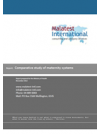This Report provides an overview of maternity systems and maternity outcomes for mothers and babies in New Zealand and six comparator countries.
Methodology
This report is based on data collected through two methods:
- Literature review:
A search was conducted of the literature available through the Ministry of Health’s library. This research was supplemented by internet based searches for grey literature and advice from interviewed key informants on relevant resources. The reliability of sources of evidence were assessed and recorded in a table of evidence used to guide the development of the report. Priority was given to evidence from Cochrane reviews and meta-analyses.
- Key informant interviews:
Malatest International worked with the Ministry of Health to identify key informants with a relationship to the maternity care system in New Zealand. A number of international informants were also identified in the course of studying their maternity systems. Researchers completed semi-structured interviews with key informants discussing the maternity system in their country, its strengths and weaknesses and initiatives showing good results particularly in providing care to vulnerable populations.
Key Results
Overall, the Study confirms that New Zealand maternity services are of a high standard, although there are opportunities for further improvement, in particular, improving outcomes for vulnerable populations. New Zealand has high rates of some risk factors, notably high rates of teenage pregnancy and obesity. These risk factors are over-represented in vulnerable populations. Age of first pregnancy is also rising in most countries. This is considered to be leading to a rise in rates of assisted birth. The incidence of other risk factors, such as smoking in pregnancy, is falling across comparator countries.
The Report finds that maternal and perinatal/neonatal death rates have fallen to low levels across the developed world. Further improvements require systematic investigation of maternal and perinatal deaths. A number of countries in the Study, including New Zealand, have implemented investigative systems. Morbidity rates are becoming more important as a measure of the quality of maternity care, although internationally agreed indicator measures are still to be developed.
In a number of countries, clinical outcome measures are being supplemented with social and psychological well-being measures such as consumer satisfaction.
New Zealand has been surveying maternity service consumer satisfaction for several years. As yet there is no internationally comparative reporting in this area. There is no obvious link between how maternity systems are organised and maternity outcomes, although midwife-led systems appear to have lower levels of intervention in the birth process. New Zealand and the Netherlands stand out as having the most strongly midwife led maternity systems. All countries included in the study, except the Netherlands, have seen shifts in roles and responsibilities of the different health care professionals in their maternity care systems. More recently, this has seen a trend toward increasing or strengthening the role of midwives, including in New Zealand.


